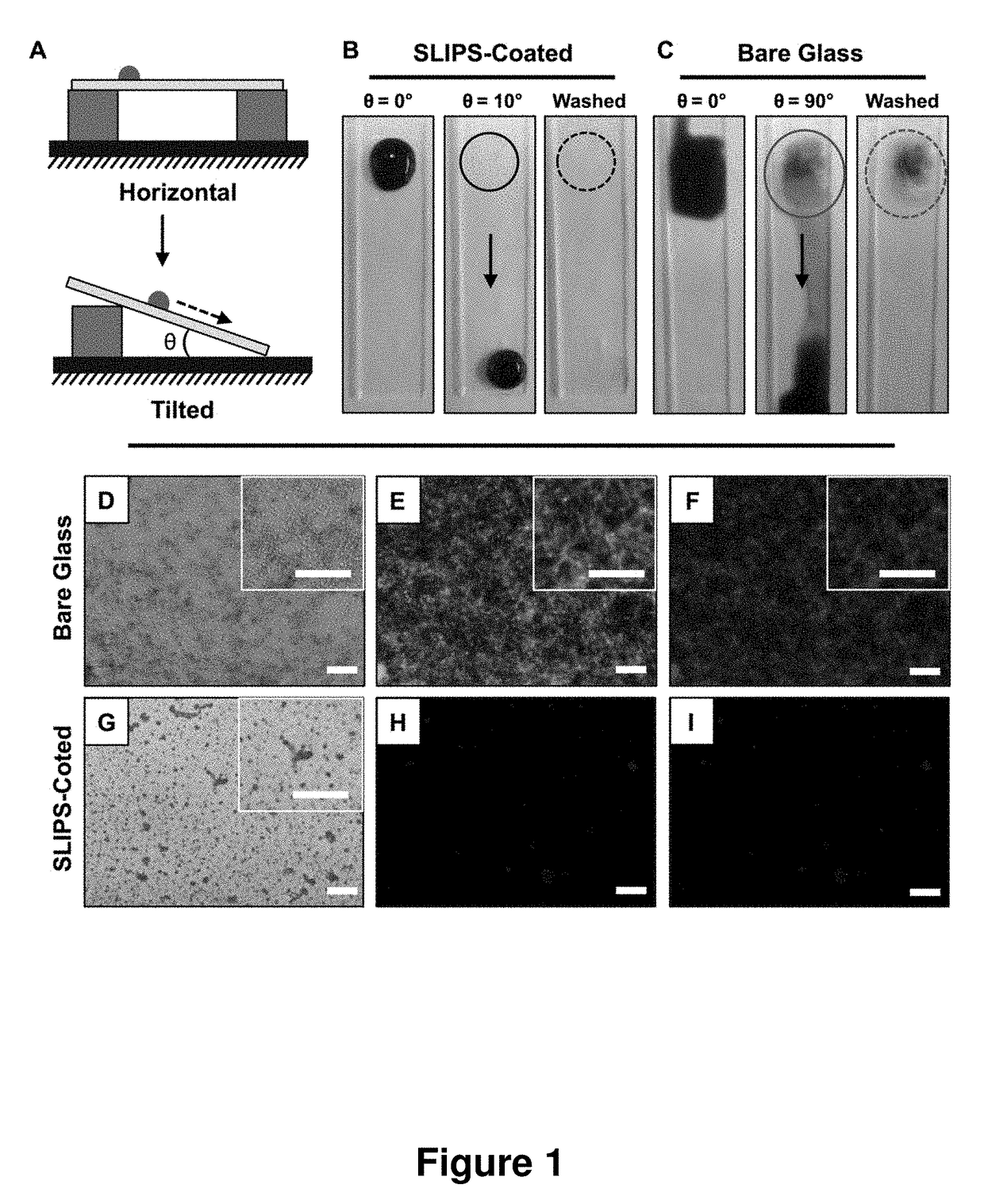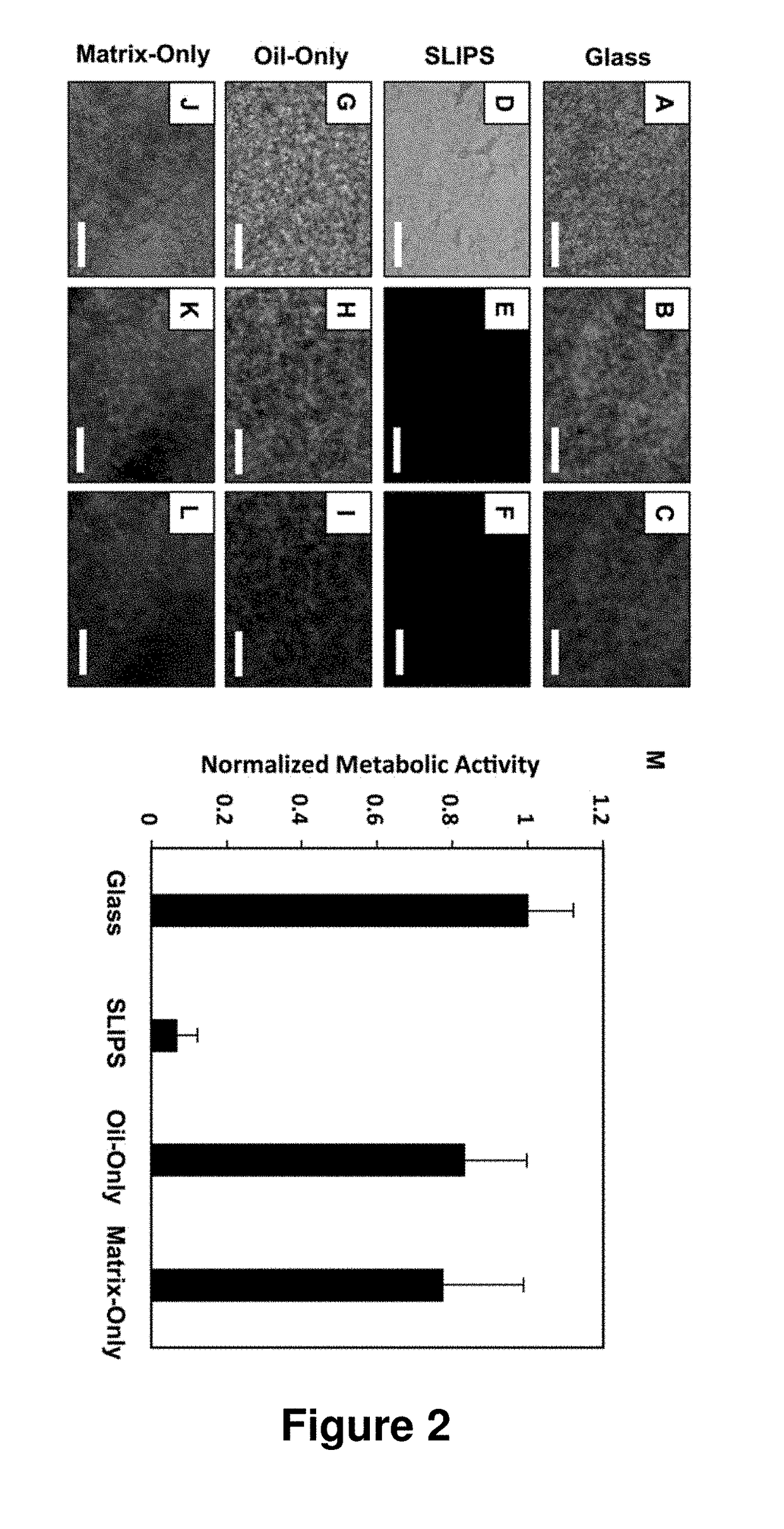Slippery Liquid-Infused Porous Surfaces that Prevent Microbial Surface Fouling
a technology of microbial surface and liquid, applied in the direction of biocides, organic chemistry, coatings, etc., can solve the problems of reducing the ability of bacteria or other substances changing the properties of the surrounding media, or reducing the ability of surrounding media to adhere to the surface, etc., to achieve the effect of reducing or inhibiting non-adherent pathogens
- Summary
- Abstract
- Description
- Claims
- Application Information
AI Technical Summary
Benefits of technology
Problems solved by technology
Method used
Image
Examples
example 1
on of SLIPS Material with an Antimicrobial (Triclosan)
[0109]Many types of slippery liquid-infused porous surfaces (or ‘SLIPS’) can resist adhesion and colonization by microorganisms. These ‘slippery’ materials thus offer new approaches to prevent fouling on a range of commercial and industrial surfaces, including biomedical devices. However, while SLIPS can prevent fouling on surfaces to which they are applied, they can currently do little to prevent the proliferation of non-adherent (planktonic) organisms, stop them from colonizing other surfaces, or prevent them from engaging in other behaviors that could lead to infection and associated burdens. The present examples provide an approach to the design of multi-functional SLIPS that addresses these issues and expands the potential utility of slippery surfaces in antimicrobial contexts.
[0110]This approach is based on the incorporation and controlled release of small-molecule antimicrobial agents from the porous matrices used to host ...
example 2
n of Adhesion Using SLIPS Material
[0147]Multilayer-Based SLIPS Prevent Adhesion of C. albicans.
[0148]It was recently reported that nanoporous and superhydrophobic polymer multilayers fabricated by the reactive layer-by-layer assembly of PEI and the amine-reactive polymer PVDMA can be infused with hydrophobic oils to design surfaces that are ‘slippery’ to a range of aqueous fluids (see Manna et al., Adv. Mater. 2015, 27, 3007). The work described here (i) characterizes the ability of these slippery oil-infused surfaces to prevent the short- and longer-term attachment and colonization of fungal and bacterial cells, and (ii) tests the hypothesis that the porous polymer matrix and liquid oil phases comprising these materials could be exploited as reservoirs for the loading and release of antimicrobial agents that could both improve the inherent antifouling properties of these surfaces and provide new strategies to kill non-adherent (planktonic) cells in surrounding media.
[0149]For all ...
example 3
f SLIPS Material on Planktonic Cells
[0173]SLIPS Loaded with Antimicrobial Agents Prevent Fouling and Kill Planktonic Cells.
[0174]One guiding hypothesis of the work described herein is that the infused oil phases of these multilayer-based SLIPS can be used to host and sustain the release of small-molecule antimicrobial agents. It is asserted that if antimicrobial agents are incorporated without degrading the inherent slippery character of these surfaces, the release of these agents into surrounding liquid media could kill planktonic cells and further prevent or reduce the likelihood of biofilm growth.
[0175]To explore the feasibility of this approach and establish proof-of-concept, experiments were performed using silicone oil-infused SLIPS and triclosan, a model broad-spectrum antimicrobial agent that can kill both fungal and bacterial cells (the molecular structure of triclosan is shown in the inset of FIG. 6 (C)). Triclosan is soluble in silicone oil and thus permits the facile des...
PUM
| Property | Measurement | Unit |
|---|---|---|
| sliding angles | aaaaa | aaaaa |
| molecular weight | aaaaa | aaaaa |
| molecular weight | aaaaa | aaaaa |
Abstract
Description
Claims
Application Information
 Login to View More
Login to View More - R&D
- Intellectual Property
- Life Sciences
- Materials
- Tech Scout
- Unparalleled Data Quality
- Higher Quality Content
- 60% Fewer Hallucinations
Browse by: Latest US Patents, China's latest patents, Technical Efficacy Thesaurus, Application Domain, Technology Topic, Popular Technical Reports.
© 2025 PatSnap. All rights reserved.Legal|Privacy policy|Modern Slavery Act Transparency Statement|Sitemap|About US| Contact US: help@patsnap.com



